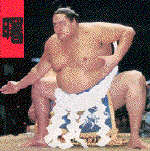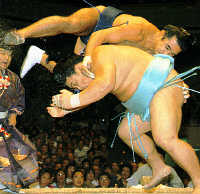It’s hot, damn hot. So hot in fact that it seems most of Tokyo has come to a standstill. I know it is now definitely summer as all the vending machines have been switched to cold. No longer can I get my morning can of steaming coffee from a vending machine and have to make to with a
can of cold tea instead.
But seriously, I really object to the phrase “Made in the
English Way”, which appears on each can. After 27 years in the UK I can never once remember seeing a can of tea, but then again, I may be mistaken.
Sumo Wrestling
September sees the Tokyo sumo basho, which is one event that you really should make the effort to see. There is a popular idea amongst the Japanese that going to see the Sumo is a tad expensive. Ask a Japanese colleague to organise some tickets for you and they will suck in
their teeth, make a whole series of expressive and noisy gestures and then declare that it is too expensive.
Well, the good news is that this is not in fact true. For a really good seat, last year we sat one row back from the emperors’s son in excellent seats, for this you can expect to pay about ¥6000. This may seem expensive, but it is hard to beat the cultural experience and is definitely a memory of Japan to treasure.
Sumo wrestling, one of the earliest forms of martial arts, is the national sport of Japan. To most Westerners, a Sumo bout is only two overweight behemoths crashing together trying to push one another out of a round ring.
Although to my untrained eye this is a fair description, experts tell me that there is much more to Sumo. In Sumo, strength and power are important but proper form and good manners are equally important (of course, being built like two brick outhouses pushed together is a definite advantage).
Watching Sumo gives a glimpse of Japanese traditions that have been preserved over the centuries. Shinto, Japan’s oldest religion, has a
strong influence on the way wrestlers (rikishi) conduct themselves in and out of the ring (dohyo). They must always act in a dignified and courteous manner. Shinto rituals, from the throwing of salt to cleanse the ring before a bout to the chopping gesture the winner performs
upon receiving his cash envelope, are just as important as the fight itself.


The current Sumo Grand Champion (Yokuzuna) is Hawaiian born Akebono (467 pounds). Another Hawaiian native, Konishiki (575 pounds) ranks as a Champion (Ozeki), the next highest level. In Sumo, strength and a winning record are not the only factors determining how wrestlers rise
through the ranks. Dignity and one’s behaviour are also considered.
History of Sumo
The earliest written mention of sumo is found in the Kojiki (Record of Ancient Matters), a book from the year 712, which is the oldest existing example of Japanese writing. The Kojiki relates a legend about how possession of the Japanese islands was determined by a sumo match.
According to the book, about 2,500 years ago, the gods Takemikazuchi and Takeminakata grappled on the shores of Izumo along the Japan Sea coast in what is now Shimane-ken, until the latter finally lost. Thus control of the archipelago was ceded to the Japanese people led by
Takemikazuchi, who is said to have established the imperial family from which the present emperor traces his ancestry.
Sumo in its early days tended to be violent with no holds barred – often a veritable fight to the finish. The Nihon Shoki (Chronicles of Japan), from 720, records the first bout between lowly mortals as taking place in 23BC. Emperor Suinin (r.29BC – AD70) is said to have made a
special request to Nomi no Sukune, a potter from Izumo, to fight Taima no Kehaya, a bully and braggart from what is now Nara-ken. The two grappled for quite a while until Sukune finally rendered some devastating kicks to Kehaya’s stomach and solar plexus. Kehaya was mortally wounded, and Sukune, the victor, has been immortalized ever since as the “father of sumo”.
There are several other legends about sumo matches held in the Imperial presence before Japan adopted the Chinese writing system in the 7th
century. The first historically authenticated bout took place in 642, when Empress Kogyoku (r.642-45) assembled her palace guards to perform sumo to entertain envoys from the Paekche court of Korea. Later records mention sumo being performed at the functions of the Imperial court, including at coronation ceremonies. The custom of ‘tenran-zumo’ (sumo in the Imperial presence) is still carried out at present, albeit in different form.
These 70 techniques, as approved by the Sumo Kyokai (Council), cover all of the ways one may win/lose in the sport, though many of these are never seen. However, the general ideal is to either push your opponent out of the ring or to make a part of his body other than his feet touch the floor. A typical sumo bout can be over in a matter of seconds.


The real joy in a sumo event, at least for me, is the pomp and ceremony which begins the bout. An archaic form of Japanese is used for all announcements which even the elderly Japanese have problems with.
My advice is to sit back, relax, drink some beers and enjoy. My money is on the fat man.
General Info Section
Japan, with a population of 125 million, is one of the most densely populated areas in Asia. Tokyo, its glorious capital city, throbs to the beat of 8 million people, all of which seem to be in Ueno station on a Saturday afternoon.
It is the land of sumo, sushi and kimono, a land where the delicate kimono clad lady fights against drunken salary men for a seat on the subway. A land where one’s preconceived ideas are often shattered and replaced by something much more surreal.
Geography
Japan is in eastern Asia and an island chain between the North Pacific Ocean and the Sea of Japan, east of the Korean Peninsula. Here’s a better view.
Accommodation
Like any big city, Tokyo can be expensive. However, there is no need to spend any more money for a decent place to sleep then if you were staying in a major European capital. Tokyo has more then its fair number of super expensive 5 star hotels, but tucked away down the back
streets are some of the funkiest, coolest hotels anywhere in Asia.
A night in a love hotel will set you back upwards of 5000Y, which is about half the normal room rate for a conventional hotel. The only drawback is the rooms are only rented for the night after 11pm. But as most of these hotels are close to pubs and bars, it never seems a problem.
A book source of information on hotels.
Long term residents details on housing.
Transport
Most people enter Japan through either Tokyo’s Narita or Osaka’s Kansai International (KIX) airports. Narita airport has recently undergone a face lift which means it is no longer one of the worst airports in the world. Terminal 2 is particularly impressive, though how long it
will stay this way is another matter.
From there trains link to major cities in their respective areas and also to Tokyo station (from Narita) and Shin-Osaka station (Kansai) from
where you can change to Shinkansen (bullet) trains which will take you to other cities in Japan.
Getting around is easy on the speedy and convenient subway.
Although often crowded it is cheap, clean and safe.
Money
Yes please, lots of it. Seriously, Tokyo can be expensive, but it doesn’t need to be. With a minimum budget of about 50 US dollars a day, you can live like a king. If you start eating from convenience stores, sharing rooms in love hotels, keeping off the beers and getting
round on foot or subway, 35 US a day would be sufficient.
Set price menus are generally cheap, especially at lunch time. As an alternative, all convenient stores sell tasty lunch boxes which
range from the culinary incredible to the sublime. Check out the summer eel, which at about 500 Yen for a box, is divine.
Traditional Japanese souvenirs need not blow a hole in your budget
either. Check out the convenience stores for weird and wonderful things like sock glue, dried squid and sheets of seaweed.
For the best of the rest check out this site.
The Author
The author has been living in Japan for just over a year now and once got arrested in Malawi for gun running. He divides his time between freelance writing, research and a very nice beach in Mexico. A recent trip to Tibet has left him with the impression that the world is stranger then he previously believed.
You can find weekly updates here, or send a email to [email protected]